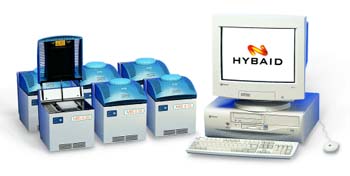Lightning-Fast PCR
If it's just sheer numbers of reactions—getting the largest number of a particular reaction done as fast as you can—large capacity thermal cycler machines could be your ticket out of the lab. MJ Research, Inc.'s (Waltham, MA) Tetrad is among the leaders here with an instrument that holds four 384-well plates. (That's 1336 reactions, by my count.) Multi-block machines are also available from Ericomp (San Diego), Biometra (Gottingen, Germany; available in the US through Labrepco, Horsham, PA), and Hybaid (Franklin, MA).

MJ Research's Tetrad
Hybaid offers a different solution—networking. Its new Multi-block System allows you to connect up to 30 blocks to a central computer, each independently controlled, offering perhaps the ultimate in flexibility. The configuration, both in number and type of block, is up to the user. This can save money as well as time since you can choose only as many blocks as you need. The Multi-block System offers a 384-well block platform as well as 0.2ml and 0.5ml block types, both with optional gradient capability.

Hybaid's Multi-block System
But for an even larger number of samples, your might want to check out the BioOven III from St. John Associates (Beltsville, MD). This instrument is, as its name implies, an oven, and as such, it frees you of the strictures of blocks all together. Instead of a block, the BioOven III has a 7.5 x 12 x 9.5-inch chamber, heated by fan-circulated air, and with a rotating sample platform. The oven's capacity is 236-0.5 ml tubes, 10 plates, 30 slides, or hundreds of capillaries. The combination of circulating air and rotating platform insures uniform temperature throughout the chamber. With its sample-holding platform, you can use any size or shape vessel you want—from plates to tubes, slides, or capillaries.

St. John Associates' BioOven
Then there are machines with especially fast ramp times that can get you in and out of the machine quickly. The leader here would have to be Stratagene's (La Jolla, CA) Robocycler, which sports three blocks, each held at a different temperature for the three steps in the PCR reaction. This machine physically moves the reaction tubes from one block to the next, which, in effect, eliminates ramping times entirely, since bringing the block to temperature is what takes the most time.

Stratagene's Robocycler
Roche Molecular Biochemical's (Indianapolis) Light Cycler (licensed from Idaho Technologies) takes a different approach to ramping things up. This system uses glass capillaries as the reaction vessels, and air as a medium for temperature exchange. This combination leads to ramp rates as high as 20 degrees per second, according to company specs. This machine also allows for either qualitative or quantitative (real-time) PCR.

Roche Molecular Biochemical's Light Cycler
Bio-Rad's (Hercules, CA) I-Cycler rivals the leaders in the conventional thermal cycler group in the speed category, with a stated 3.3 degrees per second ramp rate, with MJ Research's machines not far behind with 3 degrees per second.
Then, there's optimization. That can take up investigator as well as machine time. For this, several companies offer gradient cyclers—Eppendorf (Westbury, NY), Hybaid (Franklin, MA), MJ Research, and Stratagene—which allow you to run a number of different reaction conditions at once. With these machines, being able to vary the temperature of one or more steps in the three-step reaction means that a new PCR reaction can be optimized in a single experiment.
Click here for more information on using gradient thermal cyclers.
Finally, there are machines that can do multiple tasks at once. And for this category, the soon to be released Smart Cycler from Cepheid (Sunnyvale, CA) has to be at the front of the line. This machine, which will be officially launched in May through Fisher Scientific in the life science markets, has 16 independently controlled reaction sites (ICORE modules) in each Smart Cycler, which in turn can be daisy chained to five other units, making a total of 6 units or 96 independent sites. This means you can run a myriad of different reactions simultaneously. It's fast, with stated ramp up times of 7 to 8 degrees per second on the up side, and 3 to 4 degrees per second coming down. In addition, with this machine, you can monitor in real-time four different wavelengths in each of the ICOREs, as it's equipped with a unique reaction tube and optical detection system. Combining flexibility, speed, and quantitation in a single machine may make this the most versatile of the thermal cyclers currently available.

Cepheid's Smart Cycler
But it's not just about machines. There are other ways to increase your output. The next article in this series will look at innovations in microplate design, a ten-minute prep, a six-minute gel, and detection systems that will move you.
By Laura DeFrancesco
